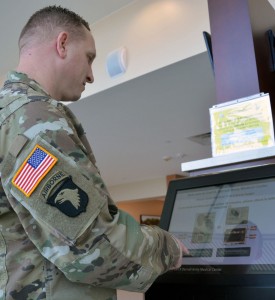
“We’ve been fully operational since April,” Thompson said, “but we’ve been moving staff and equipment to the new facility since early March,” and the first patient seen at the new facility was in late March.
One unique thing about the new hospital is while it is six stories, there are interstitial floors, making it an 11-floor building.
“Those interstitial spaces are not where patients would go, but are for our maintenance crew,” Thompson said, “this makes maintenance so much more convenient for the crew because they have their own space to work, and also more pleasing for the patients because they’re not navigating around the maintenance work.”
When the hospital transitioned, there were 124 separate sections moved – clinical departments, operational areas, administrative sections, pharmacies, specialist clinics and others.
One thing Thompson said he and the CRDAMC staff are excited about is definitely not a new concept by any means, but is new for Darnall – the space. The 944,000 square foot measurement is specifically for patients and staff; when adding in the interstitial space, the hospital rounds out to nearly 1.66 million square feet.
“The space is the biggest difference. We went from about 500,000 square feet in the old facility, to just short of 1 million square feet in this one,” Thompson said, “and much of that space is just for the patients.
“In the old hospital, there were two-, three- and sometimes four-bed rooms, and it could get cramped for the patients and their Families,” he added. “Now the rooms here are much larger and they are all single-patient rooms. None are designed to hold more than one patient.”
There is also designated space for Family members to stay with the patients in the hospital, along with doubling the parking areas for patients and staff. According to Thompson, even the emergency department has tripled in size.
“Other things we are excited about are what’s called evidence-based design,” Thompson said.
Evidence-based design is an evidence and data proven idea showing that if a hospital is built a certain way, it will allow the patients to get better and recover sooner.
One example of this idea is that every patient room has a window. “It’s been shown,” Thompson said, “if you can see outside, you’re liable to leave the hospital sooner than if you can’t see outside.
“Also, there are rooftop gardens, water features, a playground for children, balconies, art – a lot of things that we have tried to incorporate to make patients feel like they’re not in a hospital,” he added. “I think it shows as you walk around the building, you can see that it doesn’t feel so much like the stuffy hospital.”
The courtyard in the center of CRDAMC has flowing waterfalls, gardens and greenery, places to sit and eat and a memorial dedicated wall to Gen. Carl Darnall himself, honoring his memory.
“All of this is on purpose,” he said, “we’re not just showing off, this is evidence-based stuff that is proven to help patients recover quicker.”
The new facility also has a lot of new technology designed to help patients and staff navigate the hospital system very smoothly.
“Of course, there’s the typical technology – a lot of flat-screen TVs and things like that,” Thompson said, “but now we have something called Q-Flow.”
Q-Flow is a queue management system for patients that takes away the old take-a-number routine at every point in their hospital visit; from check-in, to clinic, to pharmacy.
“What we have here now is a patient will take their number when they check in for their appointment at their specific clinic,” he explained, “and as they finish at their clinic, that clinic has the ability to then send the patient’s info to wherever they are going next; and when they get to the next point, all of their information and dealings with that specific visit are already waiting for them at their destination.”
For example, when a patient finishes up at their family medicine clinic, and then needs to go to the lab, Q-Flow already has their order waiting for them to help their entire hospital visit flow smoothly. This works with every department in the entire facility; from the pharmacy to radiology and everything in between.
Thompson said in the trials with Q-Flow, for a patient leaving their clinic and going to the labs, pharmacy, etc., their entire hospital visit was cut down by at least 45 minutes.
“Rather than taking a number at every single stop,” he said, “this helps patients, their care providers and the administrators flow much more smoothly and more quickly.”
From the beginning of a visit, CRDAMC receptionists are waiting to help guide patients in the right direction. The receptionists are there for that purpose – to answer questions and help direct – which is not typical in any standard hospital. If patients or hospital visitors wish to bypass the receptionists, they can use one of the prominent maps in CRDAMC’s lobby to direct them to their destination. And for an even more detailed directory, patients can use one of the multiple automated maps placed throughout hospital. These automated maps are touchscreens that allow visitors to type in where they want to go, and from where they are, a path is drawn out for them in front of their eyes.
“Communication between physicians has also been majorly improved compared to the old communication style,” Thompson explained. “Now, we can contact each other all the time and always know what’s needed and what’s going on.”
There are also satellite pharmacies in both the emergency and pediatric departments, along with the main pharmacy near the main lobby.
“Both of the satellite pharmacies provide and easier flow for patients with specialized needs,” he said. “And it also takes some of the business away from the main pharmacy, making waits shorter there.”
CRDAMC also has a brand new dining facility which even includes a brick oven pizza station and various lines for a variety of foods, much like the other DFACs on the installation, as opposed to a typical hospital cafeteria. The CRDAMC DFAC also has plenty of seating and restaurant-style areas for patients, staff and visitors to have a meal. Coming soon to the new hospital is also a Starbucks near the main pharmacy.
“Looking forward, medically related, we want to make sure that since we have this great new facility – are we providing the level of care that we can? Are we taking care of all of the patients that we should be taking care of, and is there more that we could be doing?” Thompson said. “The answer to those questions is ‘yes.’ And we are still talking about bringing on even more intensive care staff, to increase our care ability in that area.”
Thompson said he and CRDAMC staff and leadership want the answer to be ‘yes’ for being able to take care of Fort Hood’s Soldiers, Family members, veterans, retirees and beneficiaries at all levels.
“We want to do that here,” he said, “and we know we can. We don’t want to have to send them to other places. So we’re talking about upgrades in staff members in the emergency department and more.
“It’s not that we need more stuff, it’s that we need more people,” he said, “that’s our next big thing as we move forward.”
Even though the CRDAMC has been up-and-running, the ribbon cutting acted as a celebration for CRDAMC leadership, hospital staff, community leaders, Soldiers and Family members who have waited for this new, patient-friendly, staff-friendly and almost resort-like facility – but, Thompson said, the new facility (while needed and long-awaited) is not the point.
“It’s nice and it looks pretty,” he said, “but we really have an opportunity here to not just move into a new building, but to really transform how we’re delivering care. And it comes in so many different ways.
“We want to turn around the reputation of Darnall not being exactly the kindest, friendliest place for patients,” he added. “We want to change that. We’ve changed buildings, and changed out attitudes. What can we do to really make the experience for our patients in this facility as great as possible? We need to make it what the patients want it to be, not what we think it should be.”
Thompson called the move an obvious transition, but an opportunity for a positive transformation – for the hospital and for the patients, particularly.
“It’s great to move into a big, shiny new building,” Thompson said, “but organizations rarely get a chance to transform like what we have here – this organization might not get another chance like this for another 50 years.
“We’re grasping this opportunity,” he concluded, “making changes for our patients, how we deliver care and what services we deliver.”
Authored by: Erin Rogers
Published by: Ft. Hood Sentinel




